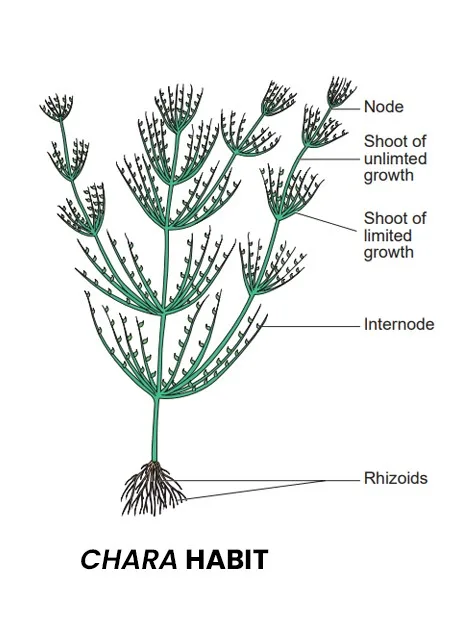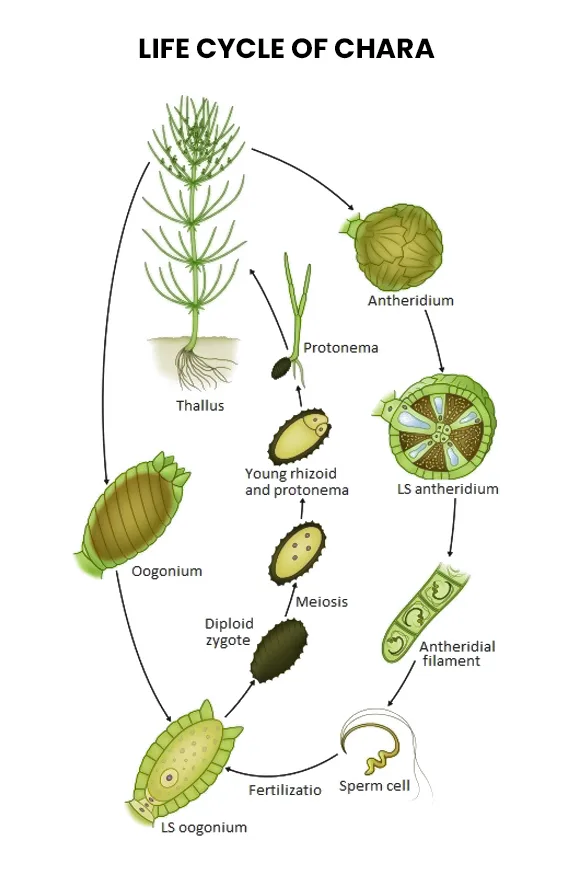
Chara: Chara is a green algae from the Characeae family. These algae are multicellular, with stems and leaves similar to those found in land plants. They are commonly found in freshwater, particularly in limestone-rich areas of the northern temperate zone, where they live submerged and attached to the muddy bottom. Chara algae thrive in environments with low oxygen levels and hard water, and they are typically absent in water bodies containing mosquito larvae.
These algae are distinguished by a layer of calcium carbonate (CaCO3) deposits, giving them the common name stoneworts. Cyanobacteria have been found growing as epiphytes on Chara surfaces, potentially aiding in nitrogen fixation, which is essential for plant nutrition. The article below provides detailed information about the structure, life cycle, reproduction, diagram, characteristics, and more of Chara algae for the NEET exam .What is Chara?
Chara, commonly known as "stonewort," comprises about 188 species, with 30 found in India. These algae are encrusted with calcium and magnesium carbonate in heavy water, making them strong and stonewort-like. They typically grow submerged in freshwater bodies like ponds, lakes, and tanks. Some species, like C. tragilis, thrive in hot springs, while others, like C. baltica, prefer brackish water. Chara, a type of green algae, belongs to the Characeae family. Its structure loosely resembles that of land plants, with stem-like and leaf-like structures. These multicellular organisms flourish in freshwater, particularly in northern temperate zones, where they attach to the muddy bottom. They prefer less oxygenated water and are absent in environments with mosquito larvae.Chara Diagram
The following is the diagram of Chara:
Chara Structure
Chara, also known as stoneworts, is a multicellular, freshwater green algae with a distinctive and intricate structure not commonly found in other algae. The structure of Chara can be described as follows: Main Axis: The main body of a Chara plant is called the main axis. This axis is divided into segments called nodes and internodes. Nodes are points along the main axis where branches emerge, while internodes are the sections between nodes. Branches: Chara displays a complex branching system. The main axis bears whorls of branches arranged in a pattern that resembles the structure of a horsetail plant (Equisetum). There are two primary types of branches:- Primary laterals : These are short branches with limited growth that emerge in circular patterns from the nodes of the main axis.
- Secondary laterals: These are long branches with unrestricted growth that also arise from the nodes of the main axis. They possess whorls of primary laterals at their nodes.
Chara Classification
The taxonomic classification of chara is as follows:| Taxonomic Classification of Chara | |
|---|---|
| Kingdom | Plantae |
| Division | Charophyta |
| Class | Charophyceae |
| Order | Charales |
| Family | Characeae |
| Genus | Chara |
Chara Characteristics
The detailed characteristics of Chara, a genus of green algae, are presented in the following points:- Appearance: Chara is a multicellular green alga that resembles a plant, featuring a stem-like main axis with whorls of branchlets at regular intervals.
- Structure: The main axis of Chara, known as the primary axis, is cylindrical and can grow several centimetres long. It is covered with nodes and internodes.
- Nodes: Nodes are points on the main axis where whorls of branchlets arise, also serving as reproduction sites in Chara.
- Internodes: These are the regions between two nodes, elongated to provide structural support to the organism.
- Branchlets: Small, leaf-like structures that arise from nodes and are arranged in whorls around the main axis.
- Reproduction: Chara reproduces both sexually and asexually. Asexual reproduction occurs through fragmentation, where a part of the plant breaks off to form a new plant. Sexual reproduction involves the production of male and female gametes, which fuse to form a zygote.
- Habitat: Chara is commonly found in freshwater environments like ponds, lakes, and slow-moving streams, preferring alkaline or slightly basic water conditions.
- Ecological Importance: Chara is crucial in freshwater ecosystems, providing habitat and food for various aquatic organisms and helping maintain water quality by absorbing nutrients and oxygenating the water.
- Taxonomy: Chara belongs to the Charophyta division of green algae, which is closely related to land plants and shares characteristics such as cellulose cell walls and similar reproductive structures.
- Uses: Chara has been used in traditional medicine for its supposed medicinal properties and is used in freshwater aquariums as a decorative plant.
Sexual Reproduction in Flowering Plants
Chara Reproduction
Chara reproduces through both vegetative and sexual means.Vegetative Reproduction in Chara
Chara can also reproduce asexually through vegetative propagation. This can occur in several ways:- Bulbils: Small, spherical, or oval bodies that develop on shoot or root nodes, detach, and germinate into new plants.
- Amorphous Bulbils: Aggregations of cells at nodes that detach and germinate into new plants.
- Amylum Stars: Multicellular aggregations with a star shape and filled with amylum starch, found in the basal region of nodes.
- Secondary Protonema: Thread-like structures formed in basal cells of rhizoids, giving rise to new plants.
Sexual Reproduction in Chara
Chara reproduces oogamously. The male sex organ, called the globule, is spherical and yellow to red. The female sex organ called the nucule or oogonium, is oval and greenish, borne on a branch mingled with secondary laterals. The nucule is situated singly above the globule. Chara species can be homothallic or heterothallic.Structure of Globule
Mature globules are yellow to red and spherical, consisting of eight outer curved shield cells, each giving rise to a central rod-shaped manubrium. The manubrium extends into primary and secondary capitula, which give rise to antheridial filaments containing antheridia producing biflagellate, uninucleate, and coiled antherozoids.Structure of Nucule
The nucule is oval, borne on a small stalk, and consists of a central cell with a large egg at the top. It is covered by spirally twisted tube cells, except at the top where corona cells are present.Fertilisation
During fertilisation, the tube cells separate to form narrow slits through which an antherozoid enters and fuses with the egg to form an oospore.Germination
The oospore divides meiotically to form four haploid nuclei, then divides into two cells: an upper lenticular cell with one nucleus and a lower basal cell with three nuclei. The lenticular cell extends and divides to form a protonemal initial and a rhizoidal initial, giving rise to the plant body and rhizoids, respectively.Chara Life Cycle Diagram
The life cycle of Chara, a genus of green algae, is fascinating and involves several stages. Chara reproduces both sexually and asexually, depending on environmental conditions.- Gametophyte Stage: The life cycle begins with a haploid gametophyte, which is the dominant phase. The gametophyte consists of a cylindrical main axis with whorls of branches. The branches are specialized for different functions, such as reproduction and anchorage.
- Sexual Reproduction: Chara reproduces sexually by producing male and female gametes. The male gametes, or antherozoids, are produced in structures called antheridia, while the female gametes, or oospheres, are produced in oogonia. The antherozoids swim toward the oogonia and fertilize the oospheres, forming zygotes.
- Zygote Development: The zygote develops into a diploid sporophyte. This stage is short-lived compared to the gametophyte stage. The sporophyte consists of a single axis with nodes and whorls of branches.
- Asexual Reproduction: Chara can also reproduce asexually through fragmentation. When the main axis or branches break, they can develop into new individuals under suitable conditions.
- Sporophyte Stage: The sporophyte produces haploid spores through meiosis. These spores are released into the water and can germinate under favorable conditions, starting the cycle anew.
- Environmental Adaptations: Chara exhibits adaptations to survive in various aquatic environments. Its sturdy cell walls and branching pattern help it withstand water currents. It also has a high tolerance for changes in water depth and temperature.
- Ecological Importance: Chara plays a crucial role in aquatic ecosystems. It provides habitat and food for various organisms, helps oxygenate the water, and plays a role in nutrient cycling.

| Other NEET Biology Topics | ||
|---|---|---|
| Ribosomes | Pollination | Apomixis |
| Centrosome | Embryo | Tissues |
Chara is Monoecious or Dioecious
Chara exhibits two main reproductive strategies: monoecious and dioecious. Monoecious: This is the more common scenario, where a single Chara plant possesses both male and female reproductive organs, known as antheridia and oogonia, respectively. However, these organs are located in different parts of the same plant. Dioecious: In certain species, Chara displays a dioecious reproductive system. This means there are distinct male and female plants. Male plants only possess antheridia, while female plants only possess oogonia. These reproductive strategies contribute to the diversity and reproductive success of Chara species in aquatic environments. PW's NEET Online Coaching provides comprehensive preparation for NEET aspirants. Live classes, PDF notes, and daily practice problems ensure thorough learning. Dedicated faculty and peer-to-peer doubt-solving foster collaborative learning. Scheduled tests track progress. Explore our courses for effective NEET preparation.| NEET Exam Important Links | |
|---|---|
| NEET Syllabus | NEET Biology Diagrams |
| NEET Biology MCQ | NEET Biology Chapter wise Weightage |
| NEET Biology Notes | NEET Previous Year Question papers |
Chara FAQs
What is the morphology of Chara?
Chara is a green, branched "charophyte" algae that attaches to sediment using underground rhizoids. It resembles terrestrial plants due to its stem-like and leaf-like structures, although it lacks adaptations for living above water.
What are the characteristics of a Chara plant?
Chara is a genus of multicellular, charophyte green algae in the family Characeae. It superficially resembles land plants due to its stem-like and leaf-like structures.
What are some key points about Chara Thallus?
Chara, commonly known as stonewort, has a thallus encrusted with calcium and magnesium carbonate. It is a freshwater algae that attaches to surfaces and can grow to be 6-10 inches tall. The main axis of Chara is differentiated into nodes and internodes.
What is the cell structure of Chara like?
The erect thallus of Chara has regular nodes and internodes, with a whorl of branches at each node. The entire plant is calcified and resembles Equisetum. The internodes of the main axis consist of a single elongated cell, and in Chara, the internodes are corticated, covering the main axis.
What are some common names for Chara?
Common names for Chara include Muskgrass, Stonewort, and Sand Grass.
Is Chara monoecious or dioecious?
Chara is monoecious, meaning a single plant has both male (antheridium) and female (oogonium) reproductive organs, with the upper oogonium and lower antheridium occurring on the same plant.
Talk to a counsellorHave doubts? Our support team will be happy to assist you!

Free Learning Resources
PW Books
Notes (Class 10-12)
PW Study Materials
Notes (Class 6-9)
Ncert Solutions
Govt Exams
Class 6th to 12th Online Courses
Govt Job Exams Courses
UPSC Coaching
Defence Exam Coaching
Gate Exam Coaching
Other Exams
Know about Physics Wallah
Physics Wallah is an Indian edtech platform that provides accessible & comprehensive learning experiences to students from Class 6th to postgraduate level. We also provide extensive NCERT solutions, sample paper, NEET, JEE Mains, BITSAT previous year papers & more such resources to students. Physics Wallah also caters to over 3.5 million registered students and over 78 lakh+ Youtube subscribers with 4.8 rating on its app.
We Stand Out because
We provide students with intensive courses with India’s qualified & experienced faculties & mentors. PW strives to make the learning experience comprehensive and accessible for students of all sections of society. We believe in empowering every single student who couldn't dream of a good career in engineering and medical field earlier.
Our Key Focus Areas
Physics Wallah's main focus is to make the learning experience as economical as possible for all students. With our affordable courses like Lakshya, Udaan and Arjuna and many others, we have been able to provide a platform for lakhs of aspirants. From providing Chemistry, Maths, Physics formula to giving e-books of eminent authors like RD Sharma, RS Aggarwal and Lakhmir Singh, PW focuses on every single student's need for preparation.
What Makes Us Different
Physics Wallah strives to develop a comprehensive pedagogical structure for students, where they get a state-of-the-art learning experience with study material and resources. Apart from catering students preparing for JEE Mains and NEET, PW also provides study material for each state board like Uttar Pradesh, Bihar, and others
Copyright © 2025 Physicswallah Limited All rights reserved.
Get App









